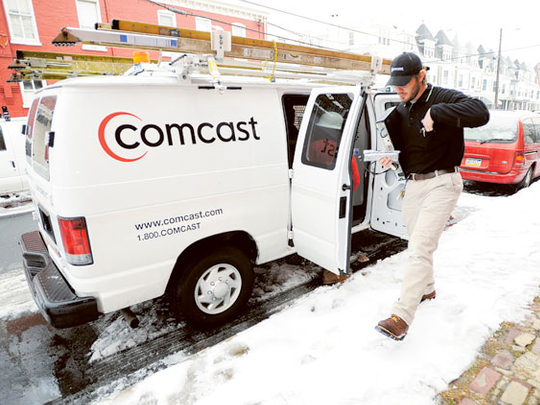
New York: Comcast Corp and Time Warner Cable Inc have soared to the top of S&P 500 media index this year, defying predictions of cable’s downfall, thanks in part to one big selling point: They don’t do business in Europe.
The two largest US cable companies appeal to investors who want to avoid the fallout from Europe’s debt crisis and currency fluctuations, said Craig Moffett, an analyst at Sanford C. Bernstein & Co Comcast has gained 44 per cent this year and Time Warner Cable shares have climbed 41 per cent, outpacing their media peers and the S&P 500, which is up 13 per cent.
The gains don’t indicate anything specifically about the cable industry, Moffett said. Portfolio managers want US cable providers as protection against Europe and Latin America, and that outweighs the specific challenges that the companies face, such as the risk that customers may switch to satellite services or Netflix Inc. The sentiment has been a boon to the stocks and other peers, such as Charter Communications Inc, the fourth-largest US cable company, which has gained 38 per cent in 2012.
“Investors are piling into cable as reasonably defensive names that have no exposure to Europe and foreign currency,” said Moffett. “None of that has any connection to the business itself. Pricing power, Netflix and cord cutting don’t even come up in the conversation.”
Cable critics point to years of cable-TV customer losses and falling video margins as signs of the industry’s decline. Comcast has reported losses in total video subscribers for 21 consecutive quarters. And programming fees — the money companies such as Walt Disney Co and Viacom Inc charge pay-TV providers to carry their channels — are increasing at a faster rate than what cable companies can pass on to customers.
The video losses suggest some customers are cutting the cord on cable altogether, opting instead to watch video with online services such as Netflix, Hulu and Google Inc’s YouTube. The evidence is mixed, as some of the cable losses can be explained by customers switching to other pay-TV services. Barclays Capital Inc’s James Ratcliffe also points to weak construction of new homes as another explanation for losses.
Stable business
“Fundamentally, we continue to view the business as stable, with video a largely zero-sum business,” Ratcliffe wrote in a note to clients.
Stability, rather than soaring growth, may be enough to persuade investors to buy, Moffett said. Comcast and Time Warner Cable’s lack of international revenue has shielded them from the euro’s 14 per cent decline and the Brazilian real’s 21 per cent fall against the dollar over the past 12 months.










